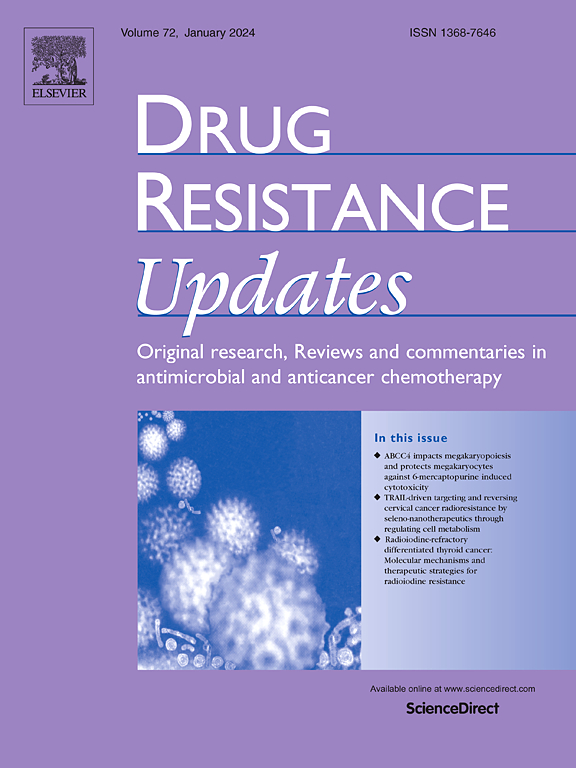Metabolic reprogramming of tumor-associated macrophages via adenosine-A2AR signaling drives cross-resistance in non-small cell lung cancer
IF 21.7
1区 医学
Q1 PHARMACOLOGY & PHARMACY
引用次数: 0
Abstract
Immunosuppression within the tumor microenvironment (TME) is frequently associated with chemoresistance. However, the mechanisms by which chemoresistance promotes immune evasion and impairs subsequent immunotherapy remain poorly understood, underscoring the urgent need for novel therapeutic strategies to counteract these effects. In this study, we observed that tumors exhibit cross-resistance to immunotherapy following chemoresistance in a non-small cell lung cancer (NSCLC) mouse model. The aberrant accumulation of tumor-associated macrophages (TAMs) and extracellular adenosine (Ado) were identified as mediators of immunosuppression, fostering cross-resistance to immunotherapy in the context of chemoresistance. Mechanistically, selective activation of the Ado/A2AR signaling pathway induced metabolic reprogramming of TAMs, thereby creating an immunosuppressive niche in cross-resistant NSCLC. Based on these findings, we designed a novel selective A2AR inhibitor DL082 and explored its therapeutic potential for treating cross-resistant NSCLC. The combination of DL082 with an anti-PD-L1 antibody significantly enhanced immune activation and inhibited tumor progression in cross-resistant NSCLC. These findings elucidate the specific mechanisms underlying cross-resistance between chemotherapy and immunotherapy in NSCLC and propose targeting the Ado-TAM axis as a potential strategy for overcoming resistance in NSCLC therapy.
肿瘤相关巨噬细胞通过腺苷- a2ar信号的代谢重编程驱动非小细胞肺癌的交叉耐药
肿瘤微环境(TME)内的免疫抑制通常与化疗耐药有关。然而,化疗耐药促进免疫逃避和损害后续免疫治疗的机制仍然知之甚少,强调迫切需要新的治疗策略来抵消这些影响。在这项研究中,我们在非小细胞肺癌(NSCLC)小鼠模型中观察到肿瘤在化疗耐药后对免疫治疗表现出交叉耐药。肿瘤相关巨噬细胞(tam)和细胞外腺苷(Ado)的异常积累被认为是免疫抑制的介质,在化疗耐药的背景下促进对免疫治疗的交叉耐药。从机制上讲,Ado/A2AR信号通路的选择性激活诱导了tam的代谢重编程,从而在交叉耐药NSCLC中创建了免疫抑制生态位。基于这些发现,我们设计了一种新的选择性A2AR抑制剂DL082,并探索其治疗交叉耐药NSCLC的治疗潜力。DL082联合抗pd - l1抗体可显著增强交叉耐药NSCLC的免疫激活并抑制肿瘤进展。这些发现阐明了非小细胞肺癌化疗和免疫治疗交叉耐药的具体机制,并提出靶向Ado-TAM轴作为克服非小细胞肺癌治疗耐药的潜在策略。
本文章由计算机程序翻译,如有差异,请以英文原文为准。
求助全文
约1分钟内获得全文
求助全文
来源期刊

Drug Resistance Updates
医学-药学
CiteScore
26.20
自引率
11.90%
发文量
32
审稿时长
29 days
期刊介绍:
Drug Resistance Updates serves as a platform for publishing original research, commentary, and expert reviews on significant advancements in drug resistance related to infectious diseases and cancer. It encompasses diverse disciplines such as molecular biology, biochemistry, cell biology, pharmacology, microbiology, preclinical therapeutics, oncology, and clinical medicine. The journal addresses both basic research and clinical aspects of drug resistance, providing insights into novel drugs and strategies to overcome resistance. Original research articles are welcomed, and review articles are authored by leaders in the field by invitation.
Articles are written by leaders in the field, in response to an invitation from the Editors, and are peer-reviewed prior to publication. Articles are clear, readable, and up-to-date, suitable for a multidisciplinary readership and include schematic diagrams and other illustrations conveying the major points of the article. The goal is to highlight recent areas of growth and put them in perspective.
*Expert reviews in clinical and basic drug resistance research in oncology and infectious disease
*Describes emerging technologies and therapies, particularly those that overcome drug resistance
*Emphasises common themes in microbial and cancer research
 求助内容:
求助内容: 应助结果提醒方式:
应助结果提醒方式:


